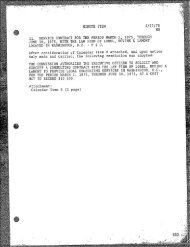Mooring Loads Due to Parallel Passing Ships - State Lands ...
Mooring Loads Due to Parallel Passing Ships - State Lands ...
Mooring Loads Due to Parallel Passing Ships - State Lands ...
You also want an ePaper? Increase the reach of your titles
YUMPU automatically turns print PDFs into web optimized ePapers that Google loves.
EXECUTIVE SUMMARY<br />
If a moving ship passes close <strong>to</strong> a moored ship, hydrodynamic loads are<br />
imparted on the moored ship. These loads must be resisted by the mooring system<br />
and include time varying surge and sway forces, as well as time-varying yaw moments.<br />
In this study, labora<strong>to</strong>ry scale model tests were conducted <strong>to</strong> measure the loads<br />
on a moored ship resulting from a passing ship moving parallel <strong>to</strong> the moored vessel.<br />
Variations in the model tests included changes in the passing vessel speed, vessel<br />
displacement, water depth, and separation distance between the two ships.<br />
The labora<strong>to</strong>ry data have been analyzed in several ways. First, empirical<br />
equations were developed that describe the variation in the peak mooring loads with<br />
changes in the above parameters. These equations notably describe the increase in<br />
loads with the increasing speed of the passing vessel, the increase in loads with<br />
increasing draft-<strong>to</strong>-depth ratio, and the decrease in loads with increasing separation<br />
between the vessels.<br />
Second, two existing predictive models were evaluated in “blind” tests <strong>to</strong><br />
determine their ability <strong>to</strong> predict the measured mooring loads. One method, developed<br />
by Flory (2002), generally under-predicted surge and sway forces, but was found <strong>to</strong> be<br />
inconsistent in the way that it includes variable displacement of the passing ship and in<br />
the way that it accounts for changing water depth. A second method, the PASS-MOOR<br />
spreadsheet of Seelig (2001) also under-predicted the measured loads but did so in a<br />
consistent way. As a result, empirical correction fac<strong>to</strong>rs were developed for use with<br />
PASS-MOOR that improve its predictive capability.

















